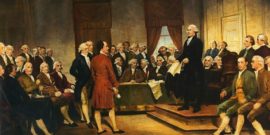We need a citizenry that appreciates the difference between decision-making authority and substantive political outcomes.
Our Supermajoritarian Constitution – Part II: The Republican Purpose of the Supermajority Rules of the Constitution
In my last post, I discussed how John McGinnis and I argue that the dominant character of the Constitution is that it is supermajoritarian. I explained that the three basic provisions of the Constitution – individual rights provision, the process for passing ordinary legislation, and express supermajority rules – all turn out to be supermajority provisions.
In this post, I want to explore some of the context and purposes of the Constitution that also contributed to the Framers establishing a supermajoritarian constitution.
The Framers of the Constitution wanted to establish a more republican version of the English Constitution. They not only eschewed a monarchy and an hereditary aristocracy, but they also believed that the English Constitution of the Glorious Revolution had been corrupted (such as by giving Parliament unlimited authority and allowing the King to purchase votes in the legislature).
At the same time, though, they were not simple democrats. They had seen how what they perceived as excessive democracy and a lack of checks and balances at the state level had resulted in instability and poor legislation. The problem was how to introduce the English limits on democracy without a monarchy and an hereditary aristocracy.
Supermajority rules were one of the principal means that the Framers employed. First, various traditional English protections were changed into ones with supermajority rules. For example, the King’s absolute veto and unilateral power to make treaties, both of which were inappropriate to a republican executive, were replaced with a provision that employed express supermajority rules (a qualified veto and the power to make treaties with a supermajority of the Senate). Conviction for impeachment, which had resided in the aristocratic House of Lords, was placed in the more republican Senate, but now required a supermajority.
Second, unlike the English system, which allowed the King-in-Parliament to pass any laws it desired, the Constitution imposed certain rules restricting the legislature, such as the individual rights provisions of the Bill of Rights. But these provisions were not made absolute; instead, they could be overridden by constitutional amendment through a strict supermajoritarian process. Finally, the ordinary process for legislation (borrowing most closely from the English system) imposed tricameralism, which operates as a kind of supermajority procedure.
Thus, the Framers established a republic, not a democracy, and they did so largely through supermajority provisions that placed checks on the public without employing either a monarch or an aristocracy.
Finally, the Framers used a supermajority rule to enact the Constitution as a whole. To establish the Constitution, 9 of the 13 states had to agree to it. (And the Framers then used a similar supermajority rule for constitutional amendments.) Thus, the entire process for enacting constitutional provisions – which was intended to preserve people’s rights and to promote the public interest – was entrusted not to a unanimity rule or to a majority rule, but to a supermajority rule.


